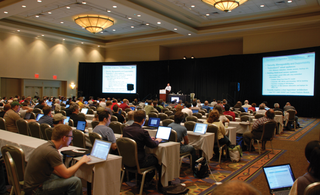
By Federico Lucifredi
The Advanced Computing Systems Association (USENIX) Technical Conference has been around for decades. Originally started in 1975 as the Unix Users Group, the 5,000-member-strong organization has evolved into a forum for operating system users and researchers, and the particularly strong influence of SAGE (the organization's special interest group for system administrators) gives the event the unique flavor of academics mingling with practitioners. Although the Unix and Unix-like roots of the organization are prominent, the large Microsoft Research contingent - and their sponsorship - illustrates the diversity of the event.
Starting on June 22, more than 600 attendees descended on the Boston Sheraton, right on the heels of the closing Red Hat Summit held next door at the Hynes Convention Center the previous week. Featuring 25 tutorials and nearly 100 sessions and presentations in a variety of formats, the conference shines in the high signal-to-noise ratio that characterizes it.
The initial volley of three days of highly specialized tutorials focused on the area of performance tuning - whether network, system, or virtualized - but was by no means limited to this topic. The "Lady of System Administration," Æleen Frisch, led a tutorial that focused on automation techniques and the latest tools in the area. Among other notable speakers, Perl evangelist Tom Christiansen and Shmoo Group founder Bruce Potter spoke on the subjects of the latest Perl 5.10 features and Botnets.
On Wednesday evening, the poster session highlighted in-progress work on the cutting edge of operating systems research and was largely dominated by virtualization topics. Among topics that stood out were Takahiro Hirofuchi's work on relocatable storage for VM live migration over a wide area that dynamically retrieves what is requested by running processes, without requiring a full preliminary image transfer to migrate the VM. Another notable effort is CORRAL, a mapper-based versioning device that leverages copy-on-write to produce stackable versioning that does not degrade read performance, requires a reasonably limited amount of space, and generally performs well enough on writes to show promise for real-use deployment in the future.
Another track featured peer-reviewed papers, focusing on research topics rather than immediately applicable techniques. On the first day, a group made up of University of Wisconsin, Madison, and Microsoft Research representatives analyzed the design trade-offs of solid state disks - a technology now reaching the mass market but with unusual I/O characteristics compared with the common storage technologies used today.
Another noteworthy piece of work was Elson and Howell's analysis of how a garage innovator could conceivably design a new, instantly successful web application that withstands the load of the inevitable, immediately gathering flash crowd by using a scalable, affordable infrastructure. The use of utility computing in schemes financially accessible to low-capital initiatives allows the authors to claim the impressive result of handling a Slashdot-class traffic barrage at a marginal cost of US$ 150.
Also, I should mention Tang, Gao, and Qin's work in the creation of a system - LeakSurvivor - by which a garbage-collecting environment can tolerate continuous memory leaks at run time. Their work was prototyped in Jikes to produce a successful demonstration of very little run-time overhead (smaller than a leak detector's), with no cumulative performance degradation.
Several keynote and invited talks punctuated each of the days of the conference. Remarkable in their technical outlook were David Patterson's talk on parallelism, Ian Pratt's session on Xen, and Matthew Melis' review of the Columbia accident investigation.
Jim Waldo, of Sun Microsystems Labs, delivered the most entertaining talk, with his humorous exploration of the difficulties involved in applying highly concurrent parallel infrastructure to the world of massively scaled multiplayer online games.
Thanks to the USENIX organization's recently announced change of policy toward more openness, all the published material is available for free review on the USENIX website. Also, Linux Magazine covered the event and recordings of the live streaming sessions are available for on-demand access at: http://www.linux-magazine.com/usenix08.